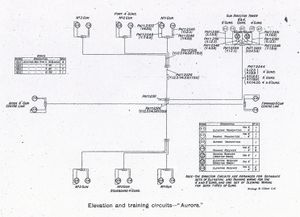Arethusa Class Cruiser (1913)
The eight light cruisers of the Arethusa Class (sometimes called the Birmingham subclass of the Town Class) were completed in 1914 and 1915.
Armament
Guns
As built, the ships had
- Six 4-in guns, 3 on each broadside.
- Two 6-in guns on centre-line fore and aft
During the war, some of the ships were altered to have
- Four 4-in guns, 2 on each broadside.
- Three 6-in guns
At the same time, the mountings for the 6-in guns were modified to permit 20 degree rather than 15 degree maximum elevation.[1]
Torpedoes
Fire Control
Rangefinders
Evershed Bearing Indicators
The Centaur class were the first light cruisers fitted with Evershed gear for gun control, but it is not clear whether older light cruisers were ever fitted.[2]
Orders for Evershed installations for searchlight control from February 1917 first applied to the Danae class, but seem unlikely to have applied to earlier ships.[3]
Gunnery Control
Control Positions
Control Groups
It seems the guns were in 4 groups, with the 4-in broadsides being separate and the 2 6-in guns being separate or jointly worked:[4] The port and starboard 4-in batteries had separate transmitters in the TS. The 6-in guns had 2 sets of transmitters in the TS with a C.O.S. to permit control from:
- fore control (presuming this means one set of transmitters in the TS)
- after control (presuming this means the other set of transmitters in the TS)
- separate control
Directors
All eight ships were fitted with directors in 1917 and 1918.[5]
The director was on a pedestal mounting without a tower. Likely, there was no directing gun.[6] The mixed armament required the director to have separate sets of elevation and training transmitting gear, though a single slewing transmitter sufficed for all guns. The director had elevation and training receivers for the 6-in guns, but not for the 4-in guns.[7]
The elevation limits of their weapons may have increased in late 1917 or early 1918, resulting in orders for adapting their director systems issued 13 November, 1917. It is not clear whether these alterations were for the entire class or just Arethusa herself, or when they were effected.[8]
Torpedo Control
Transmitting Stations
Dreyer Table
These ships had no fire control tables.[9]
Fire Control Instruments
Vickers Mark III F.T.P. to the gunsights.[10] Fire gongs fitted at each gun worked from pushes for each group (4?) in the TS.[11]
See Also
Footnotes
- ↑ Progress in Naval Gunnery, 1914-1918", p. 10.
- ↑ The Technical History and Index: Fire Control in HM Ships, 1919, p. 29.
- ↑ The Technical History and Index: Fire Control in HM Ships, 1919, p. 29.
- ↑ Handbook for Fire Control Instruments, 1914, p. 64.
- ↑ The Technical History and Index: Fire Control in HM Ships, 1919, pp. 11-12.
- ↑ Handbook of Captain F.C. Dreyer's Fire Control Tables, 1918., p. 142 and plate opposite.
I am inferring that the 2 light cruisers shown in the plate are meant to represent those with and without a tower. - ↑ The Director Firing Handbook, 1917. Plate 81.
- ↑ The Technical History and Index: Fire Control in HM Ships, 1919, pp. 14.
- ↑ absent from list in Handbook of Capt. F.C. Dreyer's Fire Control Tables, p. 3.
- ↑ Handbook for Fire Control Instruments, 1914, p. 64.
- ↑ Handbook for Fire Control Instruments, 1914, p. 64.
Bibliography
- Template:BibUKDirectorFiringHandbook1917
- Admiralty, Gunnery Branch (1910). Handbook for Fire Control Instruments, 1909. Copy No. 173 is Ja 345a at Admiralty Library, Portsmouth, United Kingdom.
- Admiralty, Gunnery Branch (1914). Handbook for Fire Control Instruments, 1914. G. 01627/14. C.B. 1030. Copy 1235 at The National Archives. ADM 186/191.
- Template:BibUKDreyerTableHandbook1918
- Template:BibUKFireControlInHMShips1919
- Template:BibUKFireControlInHMShips1919
